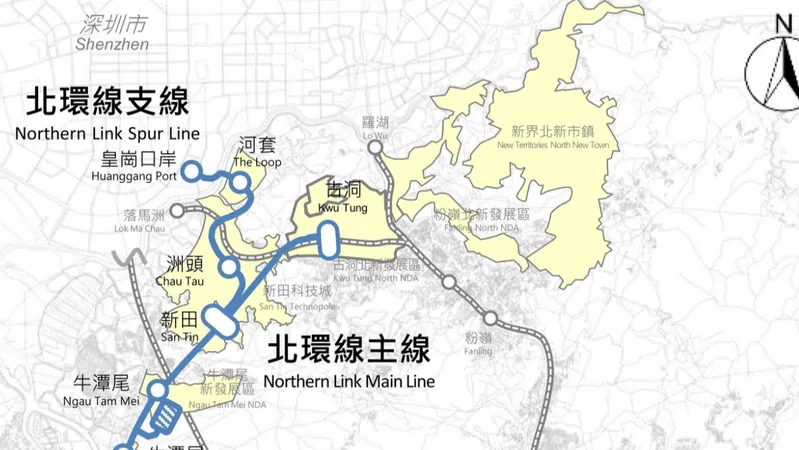
Revolutionizing Hong Kong's Infrastructure: How Mainland Expertise is Set to Slash Costs and Accelerate the Northern Link Project
2025-07-24
Author: Ting
Unlocking Cost Savings with Innovative Techniques
The Northern Link railway project in Hong Kong is gearing up for a transformation by embracing cutting-edge construction techniques from the Chinese mainland. This strategic move, which includes the use of advanced super-large-diameter tunnel boring machines (TBMs) and modular construction methods, aims to drastically reduce costs and halve the project's completion timeline.
High-Tech TBMs at the Forefront
These state-of-the-art TBMs, outfitted with 5G connectivity, artificial intelligence, and BeiDou satellite navigation systems, are poised to be pivotal in driving efficiency. With a total length of approximately 17 kilometers, the entire railway line will be developed underground, a commitment that reflects the ambitious plans laid out by Hong Kong’s Highways Department.
A New Era of Collaboration
The adoption of mainland construction practices represents a significant shift in how Hong Kong approaches infrastructure development. According to experts, integrating these techniques could lead to a multitude of benefits for both regions, enhancing productivity and cutting down costs effectively.
A Game-Changer for the Northern Metropolis
Scheduled to open by 2034—two years ahead of the original timeline—the Northern Link will serve as a key connector for the burgeoning Northern Metropolis, linking the railway seamlessly with Shenzhen’s Huanggang port. However, complications arise due to differing design standards in the cross-boundary spur line, necessitating a careful planning approach.
Building Bridges: Engineering Necessity
Lawmaker Lo Wai-kwok suggests that joint efforts in planning and design could yield a win-win scenario for both Hong Kong and mainland China. For instance, he emphasized that mainland innovations in tunnel boring could significantly streamline Hong Kong’s infrastructure projects.
Success Stories and Future Prospects
Successes like the Sky Bridge at Hong Kong International Airport, which showcases prefabricated construction techniques from Zhongshan, Guangdong province, serve as proof of the potential benefits of this collaboration. The integration of industry best practices will not only meet local safety standards but also align with global benchmarks.
Creating Unified Standards for Greater Bay Area
Efforts to establish a new set of railway specifications incorporating both mainland technologies and Hong Kong’s compliance needs could set the stage for developing unified standards across the Guangdong-Hong Kong-Macao Greater Bay Area. This collaborative framework aims to reshape railway development in this dynamic region.
Significant Cost Reductions on the Horizon
Legislator Michael Tien Puk-sun estimates that adopting mainland standards could lead to a staggering 30% decrease in overall project costs, with potential savings in the hundreds of billions. Given that a substantial portion of expenses stems from infrastructure development, this could create an unprecedented opportunity for budget optimization.
A Future Built on Collaboration and Innovation
In conclusion, while challenging historical differences in construction practices remain, Hong Kong’s government is encouraged to adopt suitable mainland standards where advantageous. By leveraging these innovations, Hong Kong can not only enhance its infrastructure projects but also pave the way for a more interconnected and efficient future.


 Brasil (PT)
Brasil (PT)
 Canada (EN)
Canada (EN)
 Chile (ES)
Chile (ES)
 Česko (CS)
Česko (CS)
 대한민국 (KO)
대한민국 (KO)
 España (ES)
España (ES)
 France (FR)
France (FR)
 Hong Kong (EN)
Hong Kong (EN)
 Italia (IT)
Italia (IT)
 日本 (JA)
日本 (JA)
 Magyarország (HU)
Magyarország (HU)
 Norge (NO)
Norge (NO)
 Polska (PL)
Polska (PL)
 Schweiz (DE)
Schweiz (DE)
 Singapore (EN)
Singapore (EN)
 Sverige (SV)
Sverige (SV)
 Suomi (FI)
Suomi (FI)
 Türkiye (TR)
Türkiye (TR)
 الإمارات العربية المتحدة (AR)
الإمارات العربية المتحدة (AR)